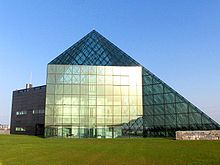- Moerenuma Park
-
Moerenuma Park (モエレ沼公園 Moerenuma Kōen) is a municipal park located in Higashi-ku, Sapporo, Japan. The park has some playground equipment, outdoor sports fields, and objects which are designed by Isamu Noguchi, a Japanese American artist. Visitors can enter the park and use the parking lot for free. Construction of the park was begun in 1988, and opened in 2005. The park won a number of awards including the Good Design Award in 2002.
Contents
History
Prior to the construction of Moerenuma Park, the place has been used as a garbage reclaimed ground since 1979.[1] Under the Sapporo Circular Greenbelt Concept, a city planning which aims at developing the urban areas of Sapporo with greenbelts and parks, the construction of the Park began in 1982. Sapporo has offered Isamu Noguchi to design the park.
Noguchi's first visit to Sapporo was in March 1988, when the place was still used as a reclaimed ground in part. Impressed with the landscape and the northern skyline, Isamu Noguchi contracted the offer from Sapporo government, and made the master plan of the park, which includes the concept of "park that is considered to be one complete sculpture".[1] On December 30 in the same year, however, right after making a miniature model of the planned park, Isamu Noguchi died of heart failure in New York, and the park was constructed with his master plan from 1989. In 1990, land reclamation of garbage in the place was totally closed. It had 71.2 ha, and 2,736,000 tons of garbage has been carried to the place until 1990.[2] In 1997, Moerenuma Park made a park twinning agreement with the Bayfront Park in Miami, United States.[3] The park won the Good Design Award in 2002, 11th Sapporo Urban Scenery Award in 2003, and Hokkaidō Red Brick Architectural Award in 2004.[2] The park has partly been opened during the construction, and on July 1, 2005, the entire construction was completed, although the park was initially planned to complete in 2004.
Outline
The name "Moerenuma" (Moere marsh) is derived from the word "Moyre pet" in Ainu language, which means "a slowly flowing river".[4] Moere marsh has already located in the place long before the park was constructed. The official name of the marsh is Shinano New River, and it is said that river was made because of perpetual river flood in the past.[4] It currently connects to the Kariki New River. The Moere Marsh is surrounding the whole area of the park ground.
The entire area of the park is 1,888,000 m² including the Moere Marsh, coming to a total cost of 27 billion yen. The park has 120 pieces of playground equipment, about 3,000 cherry trees, and the parking lots house 1,500 vehicles.[2][5] The construction is mainly supervised by Isamu Noguchi Foundation and George Sadao.
The biggest symbol of the park is a glass pyramid located near the eastern entrance. The pyramid has a nickname "Hidamari", which means "sunny spot" in Japanese. The nickname was given in 2002, which was selected from 2,340 applications.[2] With a floor space of 5,328 m² in total, the pyramid has 3 floors and a roof floor overlooking a large part of the park. The top floor houses the gallery of Isamu Noguchi, and the miniature model of the park is also located. A restaurant and museum shop are located in the ground floor. The pyramid has an air conditioning system to cool down inside in summer, by using snow stored in the neighbouring storage building during winter. Hidamari is also used as the place for some workshops and meetings in the rooms located in the ground and second floor.
The Tetra Mound, an object with triangle stainless steels (one of the creations of Isamu Noguchi) is placed in the western side, and several events have been held in the square close to the object. The Mt. Moere occupies large part of the park, and has 62 metres in height,[1] which enables visitors to overlook the landscape of the park and northern part of the Sapporo city. More playground equipment is located near the Forest of Cherry Trees and the Moere Beach, which is a shallow pond opened during summer. A 150 metres canal, the Aqua Plaza is placed in the centre of the park, and the Sea Fountain is constructed near the canal. The fountain reaches 25 meters high when it jets out, and it is closed during winter.[1] The monument called Music Shell is used as the musical venue, and it is shaped to imitate two shells swelling out from the ground - as the name indicates.
The park also contains sports grounds such as a tennis court, baseball field and athletic field. These are opened between every April and November, and the register to use these facilities is required at the management office. Visitors also can use bicycles at a rental during a day. In winter, as some facilities in the park are closed, people can enjoy cross-country skiing in the park instead. Skiing courses are set up, which enable visitors to view objects in the park whilst skiing. Cross country skiing equipment is also lent at the office in the glass pyramid.[1]
Located close to the Moerenuma Park, there is the Sapporo Satoland - a theme park focusing on the agriculture and one of the venues of the Sapporo Snow Festival. The Sapporo Community Dome, an indoor stadium which is often used as a venue for some sports events, and the Okadama Airport are also close to the park.
Sources
External links
- Moerenuma Park Japanese website (Japanese)
- Moerenuma Park Official website (English)
- Moerenuma Park and Isamu Noguchi (English)
- Moerenuma Park - Land + Living (English)
- Moerenuma Park - Images
Categories:- Higashi-ku, Sapporo
- Parks in Japan
Wikimedia Foundation. 2010.


